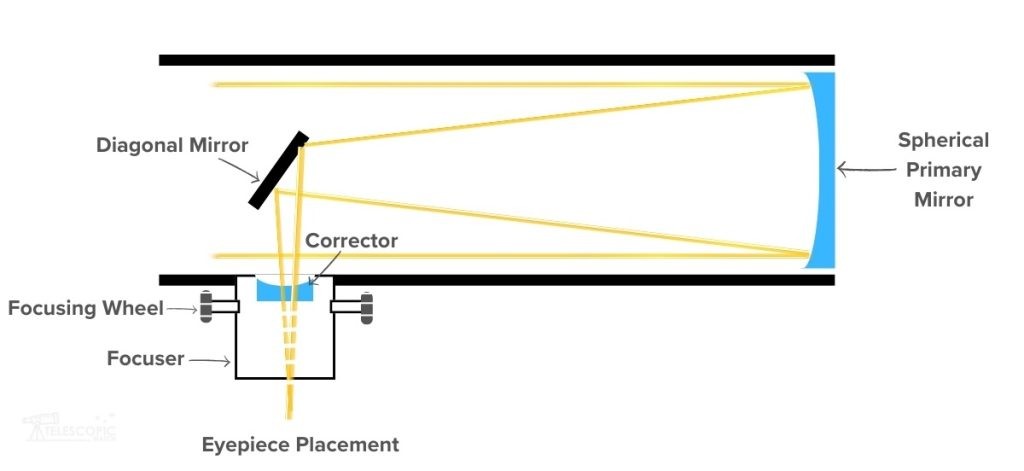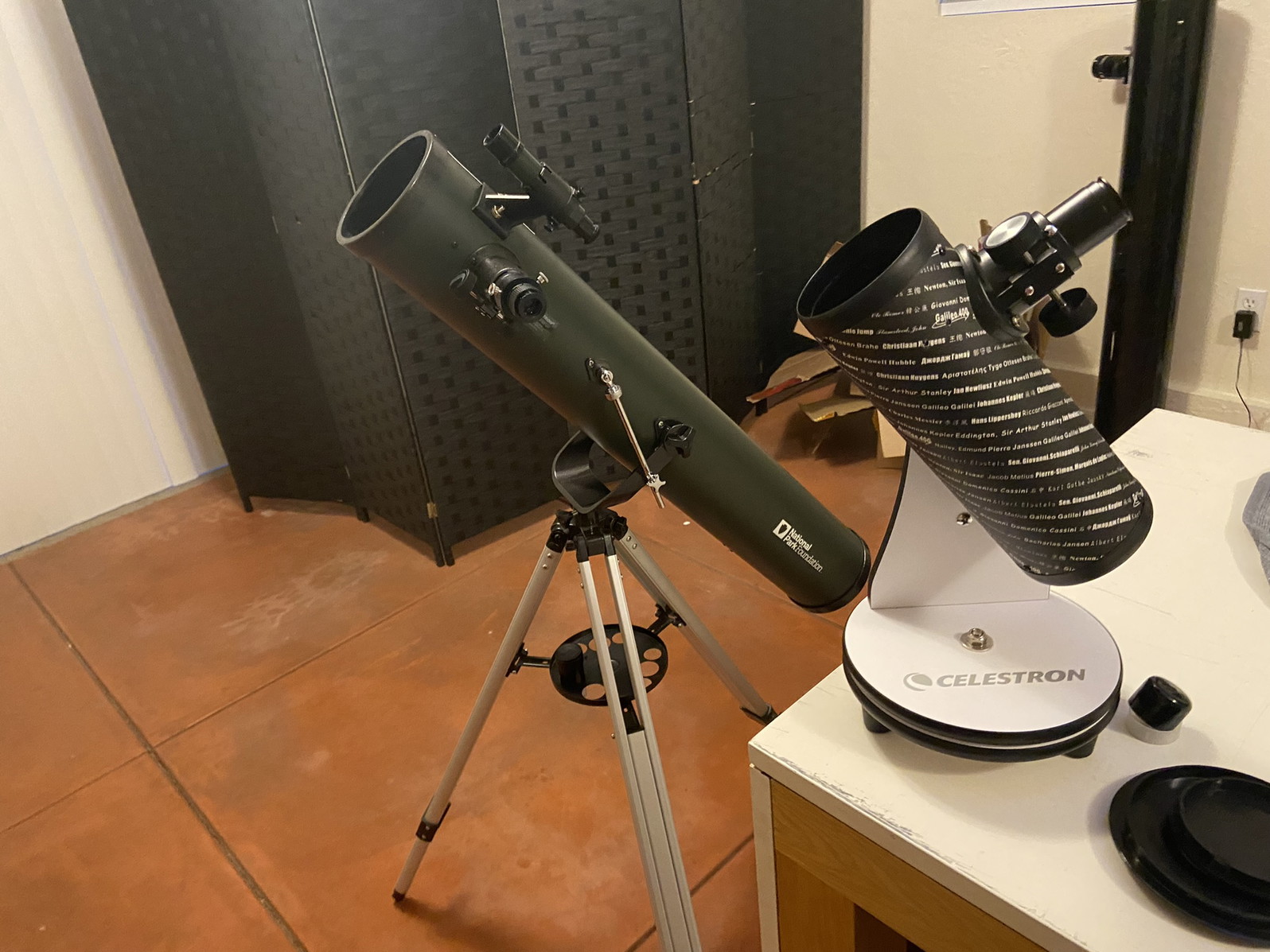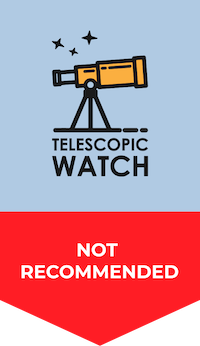The Flawed Bird-Jones Optical Design
The Celestron ExploraScope 114AZ is a Bird-Jones 114mm f/8.8. It is optically identical to the Celestron AstroMaster 114EQ and Celestron 114 LCM, both 114mm f/8.8 Bird-Jones.
Bird-Jones optical systems are based on Newtonian reflector design but in most cases, they have a poorly designed and poorly manufactured corrector lens to fix the aberrations caused by the flawed spherical primary mirrors that Bird-Jones telescopes typically use in place of parabolic primary mirrors. It’s a nice design on paper, but Celestron’s implementation of the Bird-Jones design makes for a poor-quality scope, with mushy images at best and unusable ones at worst.

I’ve also found these scopes to be very difficult to collimate. Even when I manage to collimate them, the images still fall short of being sharp. Disturbingly, the ExploraScope manual neither tells me about the existence of collimation, nor how to do it, nor that the 114AZ needs it.
The focuser on the 114AZ is a usable 1.25” rack-and-pinion unit made almost entirely out of plastic. I use an additional shim on the drawtube as it seemed to wobble a little during my usage, but the focuser is functional as-is. I did this modification only because it was very cheap and easy to do it myself.
The Poor-quality Eyepieces
Like the AstroMaster and PowerSeeker Newtonians, the ExploraScope 114AZ comes with a 20mm erecting eyepiece of a Kellner-like design, a low-quality 4mm Ramsden eyepiece that provides too much power for the scope to handle, and an outrageously bad 3x Barlow lens made entirely of plastic.
Of these, only the 20mm eyepiece is usable, and even that is not a great eyepiece.
The 20mm’s cheap erecting design and low-quality coatings result in a lot of light loss and dim images. This stupid “erecting” eyepiece design is provided solely for the function of advertising the scope for terrestrial viewing because Celestron has a habit of marketing their cheap scopes at “nature/science” stores and other places where the consumer’s knowledge is basically limited to what the scope says on the box.
Also, the field of view is quite narrow at 35 degrees or so, and the 50x magnification it provides is a little too much for a low-power eyepiece. The eyepiece also results in even fuzzier images than what is already provided by the telescope’s Bird-Jones optics.
A 32mm or 25mm Plossl is an order of magnitude better than the 20mm erecting eyepiece, as is a decent Plossl or even a Kellner eyepiece for higher magnification.
The StarPointer red dot included with the ExploraScope felt ideal for such an instrument and works well. I could easily detach and reattach it with the two-hand knobs that are provided if needed for transport.
Lastly, the ExploraScope is offered with a smartphone adapter that grips our phone and eyepiece and has adjustments to center our phone’s camera. I could take some relatively sophisticated lunar photos with these, but the planets are difficult to shoot without a mount with tracking, and a CCD/CMOS camera or DSLR would be arguably better for such a task.
AltAz Mount
The ExploraScope mount is an alt-azimuth fork design on a lightweight (but sturdy) extruded aluminum tripod.
Due to the way these mounts operate and the scopes they are designed for (long refractors), it was rather hard to get the desired fine motion capability with a very short optical tube like the Celestron ExploraScope 114AZ. But it does work acceptably.
In my experience, it’s nowhere near as good as a Dobsonian or a good equatorial mount. And it also results in a lot of frustration when trying to keep the scope aimed at a target at high magnification.
Should I buy a used Celestron ExploraScope 114?
Unless it’s free, you really shouldn’t bother with a used Celestron ExploraScope. It’s not worth much of anything.
Alternative Recommendations
The Explorascope 114AZ’s poor optics, accessories and mounting make it far from my first choice, let alone a recommendation, in any price. Here are some of our top alternative picks in their price range.
Under $200
- The Zhumell Z100 and Orion SkyScanner 100—near-identical 100mm tabletop reflectors—may be smaller in aperture than the Explorascope 114AZ, but this is more than compensated for by the superior optics, with parabolic primary mirrors free of corrector lenses in both scopes. The included accessories are well-designed; the short focal length and resultingly wide field make aiming and finding targets easier; and a tabletop Dobsonian mount is rock-solid and easy to point unlike the low-quality alt-azimuth mount and tripod supplied with the Explorascope.
- The Orion SpaceProbe II 76mm is even smaller than the Z100/SkyScanner but has a full-sized equatorial mount and tripod, decent optics, and good included accessories. If you absolutely must have a tripod-mounted scope, at this price, it would be my pick.
$200-$250
- The Zhumell Z114 offers the same aperture as the Explorascope 114AZ but with a much wider field of view, sharp optics, an easy-to-use and sturdy mount, and vastly superior included accessories.
- The Orion StarBlast II 4.5 EQ will get you a full-sized tripod-mounted scope like the Explorascope 114AZ but with good included accessories and the same great optics as the Z114. However, it’s a bit harder to set up and use compared to a tabletop Dobsonian such as the Z114 or one of the 100mm reflectors I also recommend.
$250-$350
- The Sky-Watcher Heritage 150P and Heritage 130P, both of which share the same accessories and features apart from different apertures, provide significantly brighter and sharper views than the ExploraScope 114AZ and other small reflectors, with the added benefits of a collapsible tube and high-quality included accessories.
- The Orion StarBlast 4.5 Astro is another scope I recommend, essentially a Z114 clone. It is marketed at a rather high price for what you get, however, so I’d recommend it only if my other recommended options of similar or greater aperture are unavailable.
- The Popular Science by Celestron StarSense Explorer DX 100AZ offers similarly bright views to the ExploraScope 114AZ with a convenient and well-made alt-azimuth mount and tripod, and has vastly superior optics to the low-quality Bird-Jones optics of the ExploraScope, though it isn’t as good as a 114mm reflector due to the chromatic aberration inherent in its optics. The StarSense Explorer technology bundled with this telescope also makes finding targets in the night sky a breeze with the aid of your smartphone.
For other telescope recommendations, read our article on ‘Best Telescopes’ or view our Telescope Ranking page.
What can you see with the Celestron ExploraScope 114AZ?
The Celestron ExploraScope 114AZ is far from being a particularly good telescope, but if you make some serious effort to get the thing collimated and are understanding of its limitations, there’s still a fair amount to see.
- The Moon still looks fairly good and will amaze a beginner even with a poorly-collimated instrument.
- Mercury’s phases are likely to be difficult to spot with the ExploraScope 114AZ.
- Venus’ phases should be easy.
- Mars is likely to be a red dot devoid of detail. During the few months when Mars is close to Earth every two years, a properly collimated 114AZ may just barely be able to show you an ice cap and a dark marking or two.
- Jupiter’s moons are easily visible, along with the planet’s two main cloud belts. The Great Red Spot and the brown polar zones are more difficult, but possible to see.
- Saturn’s rings are visible, and its largest moon, Titan, can be seen. Cloud belts on the planet itself are tricky, as are the other bright moons (Rhea is the easiest of the bunch). The Cassini division is probably not visible due to the 114AZ’s poor optical quality.
- Good luck finding Uranus and Neptune, let alone distinguishing them from stars.
- Globular star clusters are fuzzy balls with maybe the tiniest hint of graininess.
- Open star clusters are pretty, though the stars are less-than-sharp and could be framed better with the wider fields of view possible with faster (and better) tabletop Dobsonians.
- Bright nebulae such as Orion and the Lagoon look quite good, especially under fairly dark skies.
- Planetary nebulae are largely out of reach with the 114AZ, with a few exceptions. The Ring is tiny but bright, the Dumbbell fairly large but dim, and most others are likely to be invisible or unrecognizable.
- Galaxies are simply too small and dim to be of much interest in any 4-inch telescope, let alone one with poor optics like the 114AZ. You’ll be lucky to see the brighter Messier catalog galaxies and maybe the dust lane in M31.




I’m curious If you feel the same about the 114azSR version? I just got one for my 8 year old daughter for Christmas. It will be our first telescope, and it is actually a sort of in the moment buy. Being the fact I’m totally a novice on telescopes. But excited to learn. I couldn’t seem to pass it up considering I got it the low price of $70USD. I really just want something that’s going to provide great clarity for a great price.
If you can help I would really appreciate it. Thank you!
Sorry for the late response. It is basically the same.
I would recommend getting the Zhumell Z100 or Orion SkyScanner instead if you can afford the additional $30.
Hi I also bought the 114AZ -SR , after reading your review I am going to order the explorascope 80 AZ 80MM refractor to compare now . Is that the same one you suggested would be better ? Can you see planet details as well as or better on the refractor vs the reflector? I’ve read both are better for viewing different things , would love to see planet details good.
Both are really not good scopes.
I would recommend reading our guide for a suitable choice in your price range: https://telescopicwatch.com/best-telescope-reviews/
“Both not good scopes “ in your review of the 114 az you said the 80 mmm refractor was better . I’m new at this and already overwhelmed with the choices and have been trying to educate myself on it all and just want one to view planets and have some fun with without spending much more than $150. So just wondering is the 80 mm refractor better in fact like you previously, instead of the 114 az or are they the same for viewing planet details . Thanks in advance
Don’t now if you could help me, but I bought this for my son for Christmas and i am having trouble connecting to the wi-fi network. I have changed the battery a few times and still can’t seem to connect. I keep getting a message saying Celestron skyportal can’t make a wireless connection to the scope. I have powered on the scope and still nothing. Anyone having the same problem or did I buy a broken telescope?
Not sure if you’re asking about the right scope? The one in this review is all-manual.
If you’re asking about a Celestron Astro-Fi I would recommend calling Celestron.
How good is -explore one aurora 114mm reflector telescope
Not very. The Orion StarBlast is much better.
Hi Zane,
Im surprised you didn’t mention the skywatcher skyhawk 114p .
It has a parabolic Primary Mirror and fairly good selection of eye pieces.
Giving a much sharper image both on planets and deep sky objects.
Its easy to set up and collimate.
Not available in the US, it’s identical to the Orion StarBlast though
Hi could you help me i have purchased the 114az and im having alot of trouble the mirror inside is not lining up and i can only see a quarter of the moon i cant get it to focus or anything please help